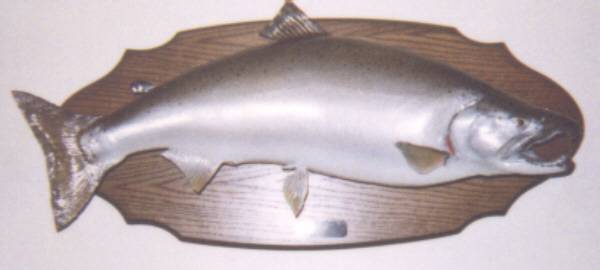
|

|

|

|

|

|

|
The coho salmon is sometimes called silver salmon and are not native to the waters of NY state. They are stocked in Lake Ontario by the DEC from eggs collected and hatched at the Salmon River Hatchery. Coho salmon are sometimes mistaken for steelhead by the novice angler for two reasons. The first being they retain the silver color in the streams longer than king salmon. The second being they are generally smaller in size on average being 10 to 20 pounds. The NY state record for a coho salmon is a 33.45 pounds.This fish was caught by Stephen M. Sheets of Woolrich, Pa., while fishing on Lake Ontario near Oswego from a charter boat. Coho salmon will roam the same open water that chinook salmon spend most of their time in. They feed on the same vast schools of alewives and smelt that are found in Lake Ontario. The coho salmon have the same genetic imprinting that king salmon have. They will also make a run up the tributaries of Lake Ontario in the fall. The coho salmon run is usually a few weeks behind the king salmon run. Fishing for coho salmon in Lake Ontario in the spring is done by running stickbaits off of planner boards. After the water warms up fishing for coho salmon is done mostly by trolling spoons and plugs on downriggers from 50 to 120 feet deep. Dipsey divers can also be used to catch salmon when they are active. Near the end of the summer the fish will respond well to cut bait run behind a flasher. Once the fish start to return to the river they may be enticed to hit a variety of baits. Egg sacs or plastic imitation eggs are among the most common used. Sponge in various colors can also be very productive. Artificial flies and streamers will also entice fish to strike. The longer the fish are in the river the more interested in spawning they become. A fresh run fish is more likely to hit your fly or egg sac. Major Lake Ontario tributaries having coho salmon runs include the Salmon River, Oswego River, Genesee River, Black River, Niagara River, Oak Orchard Creek and Eighteen Mile Creek. The coho salmon are said to be having some natural reproduction in the streams so they have become more prevalent in the lake. However they are not reproducing in sufficient number to sustain the population so they are still stocked by the state of NY. |

|
|
|
|